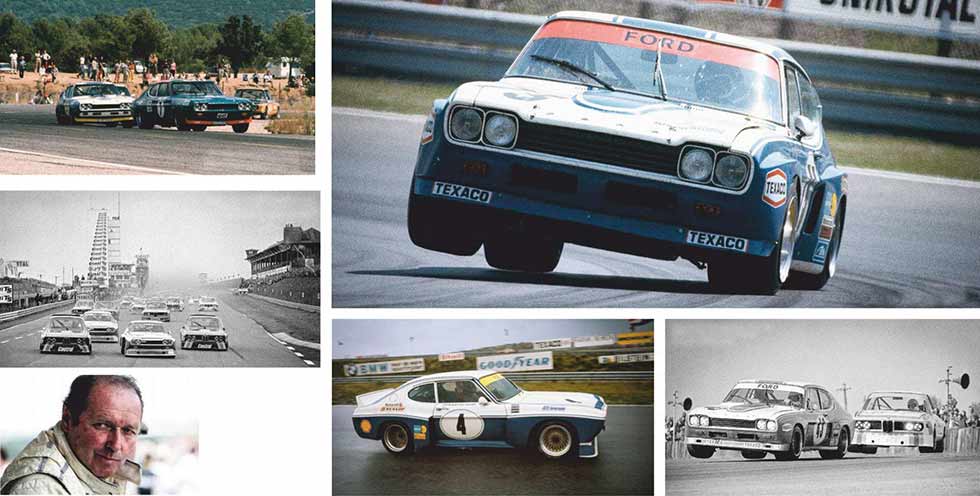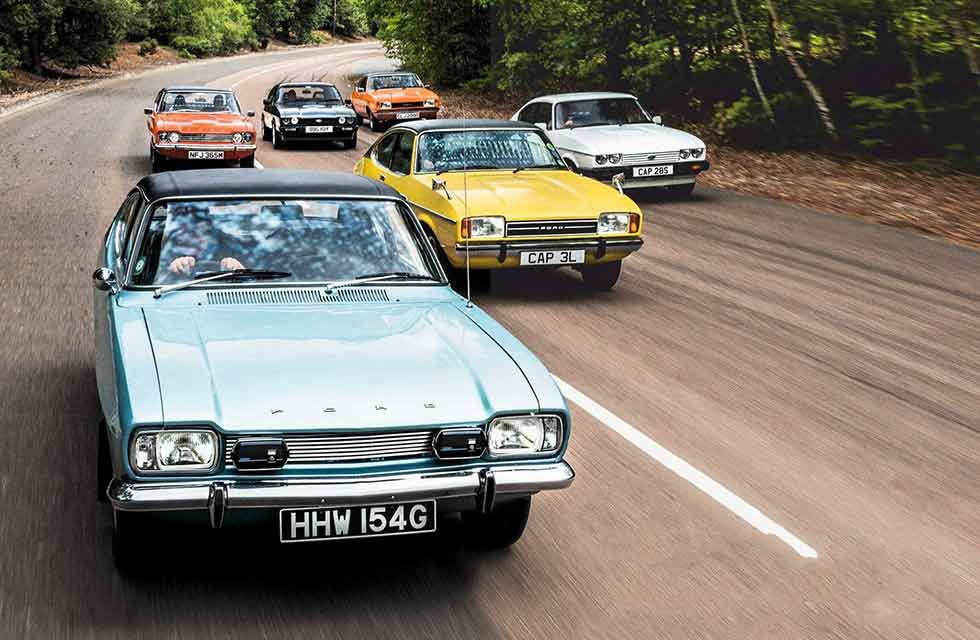
Capri at 50 As Ford‘s style icon reaches its half century, we gather all the key models from 1.3L to 2.8i to assess its impact. Plus – racing legend Jochen Mass on the RS Capris, and battling BMW in the European Touring Car Championship. It’s five decades since Ford’s groundbreaking ‘car that you always promised yourself’ hit the road. We put its key movers and shakers to the test. Words Ross Alkureishi. Photography Jonathan Jacob.
‘Looking back, my only regret is that we don’t have cars like the Capri today’ – Jochen Mass
Front to rear: MkI 2000GT XL, MkII 3.0 Ghia, MkIII 2.8i, MkI 3000GXL, MkIII 2.0S, MkII 1.3L Capri at 50 Giant test of cool coupés, from GT XL to 2.8i Special PLUS Jochen Mass on racing Capris. Big test of the key models as the Capri hits 50
Recent times have seen political correctness, corporate coffee shops and ‘fake news’ low east across the Atlantic. Yet in days gone by we’ve had more to thank our US cousins for. Ford executive Lee Iacocca’s ‘personal coupé’ Mustang had taken America by storm, offering stylish, affordable performance motoring that the buyer could customise to their heart’s delight. Cue the Capri – the American dream, made European, initiated from a design sketch by Dearborn-based Gil Spear, evolved in Dunton, UK. Taking the same basic formula – stylish body, Parts-bin underpinnings, and price consciousness – in 1969 Ford’s marketing geniuses unleashed it on a groovy British public longing to break free of stiff-upper-lip motoring.
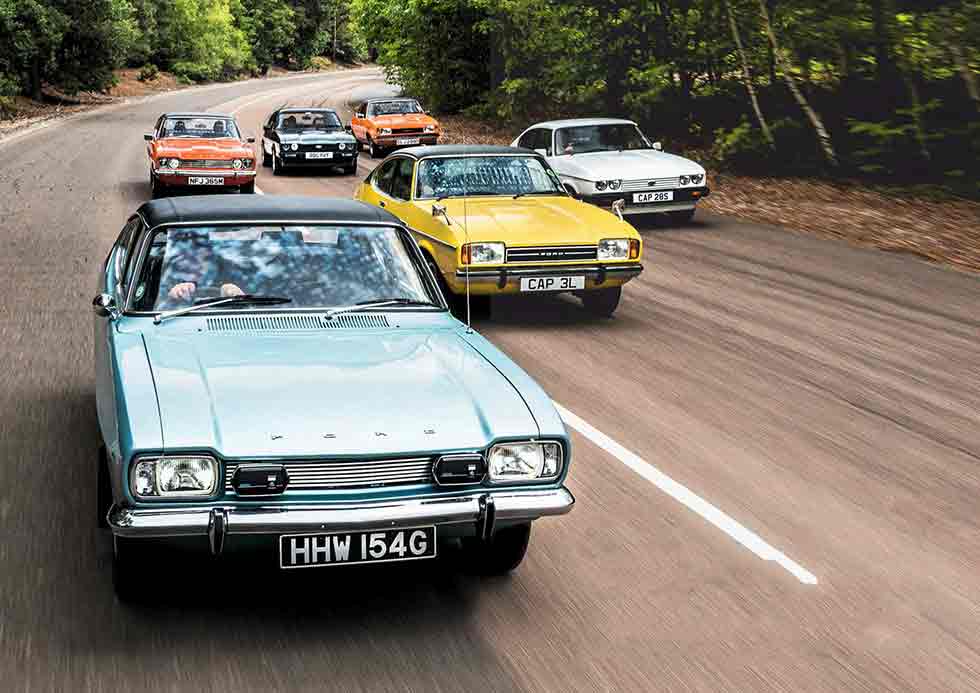
Today, the six long snouts and corresponding number of tight squat bottoms – each instantly familiar, and yet distinctly of the Seventies – sitting on our test track are a reminder that, in marketing terminology, the firm’s coupé content remained evergreen for 18 years.
Time to see exactly why more than 1.9 million consumers bought into Ford’s fabulous Capri way.
‘What would sir or madam, like?’ For the average Ford customer back in 1969, the question would have been akin to bamboozlement. ‘A Capri, please,’ they’d have no doubt thought the correct answer. ‘Ah, but what engine? The 1298cc 52bhp or 64bhp four-cylinder, 1599cc 64bhp or 82bhp four-cylinder or 93bhp 1996ccc V4?’ The next choice, ‘With or without GT?’ Transmission selected – either four-speed manual or, on the 1.6-litre and beyond, maybe three-speed automatic – it continued with dress-up packages. ‘X, L, R, XL or XLR?’ With all options accompanied by myriad flashy brochures, buyers would’ve been rubbing their palms with glee. Post-war ration-induced privations had finally been well and truly thrown of, and that great American re-invention of the Fifties and Sixties had arrived – choice.
1969 Ford Capri MkI 2000GT XL
Chris Taylor’s pre-facelift Capri 2000GT XL would have sat firmly top of the range when new. Under its bonnet is the V4 unit – as already featured in the Ford Corsair, Zephyr and Transit – incorporated in a floorplan evolved from a Cortina MkII. In fact all the mechanicals and running gear were tried and tested units – including MacPherson strut front suspension, a live rear axle and front disc brakes. The front and rear track were widened, and spring rates and dampers considerably stiffened up.
Resplendent in Blue Mink metallic, the 2000GT has an appealing purity. The fastback shape with that squat rear lends a grizzled promise of sporting prowess, while the chrome bumpers, bullet wing mirrors and thin rear lights – from the Escort MkI – offset fussier details like the fake air scoops by the rear wheelarches, vinyl roof and thick ‘hockey stick’ swage line. With the £15.01 L Pack option ticked by its first owner there are bumper overriders, metal side mouldings, and a locking fuel cap – the Rostyle wheels here from the Custom Plan R replace the standard steels.
This extra visual goodness continues inside, where the Custom Plan X adds reclining front seats, a shaped rear seat and a dipping rear-view mirror among other things. You sit higher than expected, but there’s a period simplicity to the cabin.

For all its hairy-chested visual promise, the V4 unit delivers its oomph with a breathy pleasantness. It pulls well from low revs, sounds nice and sporty and there’s ample torque, which this freshly rebuilt unit delivers relatively smoothly, but with just 104lb ft it scampers rather than charges from 0-60mph, taking a smidge over 10 seconds.
Brace yourself for the first corner and the expected wallow never arrives, at least not to the extent period road testers would have experienced. Owner Chris fitted Spax rear dampers and gas struts at the front during the rebuild to tighten the handling. That allows me to relax and enjoy the surprisingly high level of feedback offered by the rack-and-pinion steering following the Escort that was launched the year before.
As a Capri taster this MkI 2000GT certainly whets the appetite, and the visuals are pure Sixties Carnaby Street and all that jazz. If the Mustang was the automobile for the age in the ’States, then Europe now had its equivalent and with an insatiable public appetite for sporting kicks – at a rock-bottom price of £1087.53, which was £129.47 lower than an MGB GT. It was the beginning of a Capri sales frenzy. However, as a range-topper it didn’t quite cut the English mustard. Ford knew that, the public knew that and it would take the arrival of the V6 variants to deliver the go to match the Capri’s undoubted show.
Owning a Capri MkI 2000GT XL
‘I’ve owned this car for 28 years,’ says Chris Taylor. ‘It was originally green and I used it as a daily driver aged 20, but then put it in the garage and then into a field where it stayed for a long time. Seven years ago I began preparing it for restoration. It’s been a long haul, but the 50th anniversary spurred me into action.
‘Being a pre-facelift, parts were difficult to source – body panels in particular. I grit-blasted it in the garage and then put the body on a rotisserie. Working on and off at weekends the body took 12 months to complete. I had to fabricate a crossmember and where others were bad, cut bits out and replace them. I ended up refurbishing the brake calipers and master cylinder, because replacements weren’t available. I sent the original dashboard switches to Poland for refurbishment. JB Racing rebuilt the engine for £2500, but I stopped counting the cost – it was getting silly. CoFord Classics has been invaluable in helping complete the car.’
TECHNICAL DATA FILE SPECIFICATIONS 1969 Ford Capri MkI 2000GT XL
Engine 1996cc ohv V4, twin-choke Weber 32DIF carburettor
Max Power 93bhp @ 5500rpm
Max Torque 104lb ft @ 3600rpm
Transmission Four-speed manual, rear-wheel drive
Steering Rack and pinion
Suspension Front: MacPherson struts, coil springs, telescopic dampers, anti-roll bar. Rear: live axle, half-elliptic leaf springs, radius arms, telescopic dampers
Brakes Discs front, drums rear, servo-assisted
Weight 1003kg (2211lb)
Performance 0-60mph: 10.6sec Top speed: 106mph
Fuel consumption 28mpg
Cost new £1087.53
Classic Cars Price Guide £2500-£14,000

‘The fastback shape with that squat rear lends a grizzled promise of sporting prowess’
1973 Ford Capri MkI 3000GXL
The hero car finally arrived in the shape of the 3000GT in late 1969, but not before several tuning houses had themselves shoehorned 3.0-litre units into a Capri bodyshell. That thunder stealing had come as a result of Ford not committing to a V6 variant until too late in the product launch schedule – with hindsight one thing the company’s head henchos did get wrong.
The 2994cc Essex V6 – a reworked version of the Zodiac’s powerplant – significantly raised power and torque outputs, and was allied to a tougher gearbox that could cope with the extra lashings of grunt. Having usurped the V4 unit, it allowed the 2000GT to fall straight into the midrange of the model line-up that in reality it should always have occupied.
Our car is a post-facelift 1973 Ford Capri 3000GXL, resplendent in Sebring Red. And what a cracker it is. The ‘X’ ‘L’ and ‘R’ badges are a thing of the past, replaced by an optional sports custom pack for GT models, while here the GXL range-topping moniker denotes that it has all the goodies.
The rear lamp clusters aren’t as discreet as the earlier car’s, but the by-now de-rigueur bonnet hump (as per the German models, and on all models from 1972), twin-tailpipes and those quad headlights lend it a whiff of the Cologne-built homologation special RS2600’s wild aesthetic.

Toss in matt black sills, Minilite-aping 5.5J Sports Road wheels and 3000 V6 front wing badges, and our previous car looks a touch sweet by comparison – think Olivia Newton John’s transformation from pure Sandy Olsson to be-leather trousered temptress in Grease. Inside it’s ramped up on masculinity, with a deeper instrument binnacle stocked with large black-faced instruments wearing orange needles. The steering wheel is less meaty, but the gear lever is chunky and the lower seating position a distinct improvement.
Crank up the V6 and it’s a different proposition. There’s a charismatic offbeat wuffle when stationary, but get on the move and that quickly rises in tone to become a six-cylinder blare. Its later engine was mechanically re-jigged to 138bhp (up 10bhp on the 3000GT and later 3000E equivalent) but there’s still relatively little need to rev the proverbials of it, because it pulls like a husky good ’un from low down, peaking just south of 5000rpm.
It feels convincingly faster than the earlier MkI and it is, being a full 2.3 seconds quicker in a sprint from 0-60mph. The rod-change four-speed gearbox isn’t quite as sweet shifting – come back, Sandy – but the V6’s surge of constant acceleration means there’s no need to rush between the better-spaced ratios.
The brakes give initial cause for concern with an alarming lack of bite but think of them as anti-Citroën in the necessary required pressure. Thankfully a heavy boot overcomes this, revealing sharp enough levels of stopping power.
It’s also decidedly less choppy over poorer surfaces than the V4 thanks to softer springing; but barrel into a corner and it too tends to understeer and with the extra weight in its long schnozz it’s more pronounced. However, just like the earlier car it can be easily blotted out with a touch of throttle.
The V4 excelled as a GT, though its engine, while reliable, didn’t respond as well to tuning as the Kent four-cylinders. But the V6 Essex turned big brother into a true and potent mile-muncher. It was definitely the one to have.
From the of, Ford UK and Ford Germany had built its own variants, complete with distinct engine families known as Kent, Essex and Cologne. The range now included seven models and, for the final year of production, the British-built cars basked in the glory of their own ETCC homologation hero, the RS3100. And yet the model’s single biggest draw was still its price point. In January 1969 the boggo 1300, with just a paltry 52bhp on tap, cost £890.39; even the range topper 2000GT was only £1087.53. At the 1974 close of MkI play, the 3000GXL came in at a fiercely competitive £1824, still a performance bargain by anyone’s thinking.
The public agreed, gorging on all model variants and by the arrival of the Capri MkII, Ford had shifted a mightily impressive 1,209,100 units in all regions – including the USA where it was sold simply as ‘Capri’, with no Ford badging. Most were cooking to mid-range models, but the sales template had been set.
‘There’s little need to rev the proverbials off it, because it pulls like a husky good ’un’

Owning a Ford Capri MkI 3000GXL
This was originally 18-year old college student Reece Bansal’s grandfather’s car. ‘My grandmother wouldn’t let him have it,’ he explains. ‘But he said, “I’m buying it for Reece as an investment,” and that was his way of getting round her. He owned it for 17 years, only doing around 100 miles a year to shows, before leaving it to me. I don’t have my licence yet so today my dad drove it here from Birmingham, but I’ll be taking my test very soon. ‘Since owning it we’ve touched up the paint, tuned the engine, sourced an original radio to replace the aftermarket unit, and replaced a rusty exhaust silencer. We don’t have a yearly budget for running it, we just ix it when required. It’s quite thirsty compared to a modern car. ‘It’s also been to its first show in my ownership this year, where it finished third in the MkI category at the Capri Club International’s concours event in Evesham.’
TECHNICAL DATA FILE SPECIFICATIONS 1973 Ford Capri MkI 3000GXL
Engine 2993cc V6, twin-choke Weber 38DGAS carburettor
Max Power 138bhp @ 4750rpm
Max Torque 174lb ft @ 3000rpm
Transmission Four-speed manual, rear-wheel drive
Steering Rack and pinion
Suspension Front: MacPherson struts, coil springs, telescopic dampers, anti-roll bar. Rear: live axle, half-elliptic leaf springs, anti-roll bar, telescopic dampers
Brakes Discs front, drums rear, servo-assisted
Weight 1079kg (2380lb)
Performance 0-60mph: 8.3sec; Top speed: 122mph
Fuel consumption 23mpg
Cost new £1824
Classic Cars Price Guide £3750-£25,000
1976 Ford Capri MkII 1.3L
Come the new decade, and come the new Capri. Well, actually no. Come the new decade and Ford merely started thinking about the next generation; it’d actually be 1974 before it arrived. The Capri MkI had conquered the market – in fact created a new one – so how to ensure continued sales success? True to the company’s management ethos, the successes and failures of every aspect – style, substance, character and sales processes – of the outgoing model were analysed to the nth degree.
The one key unchangeable factor was that it would be built on the same platform, a common Ford procedure, but designers had free reign in terms of the bodywork it wore. Out went the Mustang-esque fake vents and pure Americana of the hockey-stick body swage line, and in came smooth slab flanks and rectangular headlights on all models for cleaner, less belligerent look. And a hatchback! Yes, the people had spoken regarding a lack of luggage room, and this was the result.
Despite the MkI having had a fairly recent engine roster tweak, the biggie for MkII was the deletion of the stolid V4 Essex unit, replaced by the new overhead-cam 2.0-litre Pinto good for 98bhp. Which is precisely what we don’t have here. No, this is one of the great survivors. Not a cooking, but a budget cookery model – a later 1976 Capri 1.3L. In fact strictly speaking there was a lower, non-L base model, but good luck finding one today.
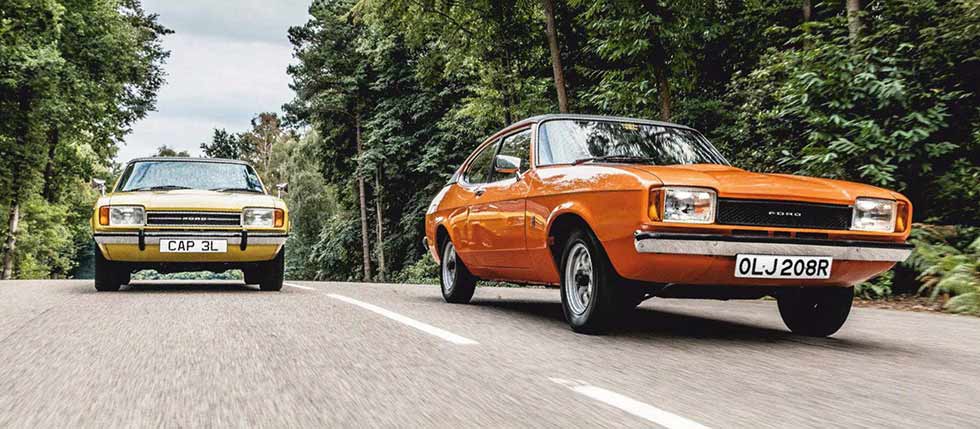
It’s a bit more plain-Jane to the rockabilly MkI, with none of that reflective Sixties retro-cool and, rather like the subsequent decade, it’s taken a bit longer for it to come back into fashion. Those large front headlight lenses almost give it a bespectacled air, compared to its sharp rectangular-eyed predecessor the 2000GT – and as for its brooding mean and moody MkIII replacement there is simply no contest.
Pop the bonnet when new and that pea-sized power plant would surely have had you struggling not to run to trading standards complaining about the inclusion of a power bulge – if the V4 was compact, then blink and you’d miss this.
However, with the decade firmly in the grip of an energy crisis caused by the Yom Kippur war, this was the response of the never-ones-to-miss-an-opportunity ad men. The recipe? Take the 1298cc Kent unit and it an 1100 cylinder head to it with Ford’s own carburettor for an underwhelming 50bhp – hey presto, the lowest-powered Capri yet, but one that’d return a healthy combined fuel consumption of circa 30mpg.
Not many survive, but then not many were sold. For a model built on added visual va-va-voom, having the base model – whatever the straitened times – was never really going to appeal to boy racers, medallion men or sharp dads about town; it wasn’t as if you could jazz it up with a little X, L or R packs and their respective badging, because now distinct trim levels were in play for the model hierarchy.
This car’s interior is budget basic with the synthetic luxury of the more exalted replaced by cloth seats, a twin instrument binnacle swathed in faux wood veneer. The glass area has been extended by almost a third – it’s not quite Georgie Best’s goldfish bowl house, but it aids visibility.
On the hoof it’s strictly pedestrian. It doesn’t run out of breath so much as, by the time it actually finally gets going, it’s run out of gears. If ever a car needed a fifth cog… The chassis hangs on well when giving it some, but in truth you’re not really carrying enough speed to get truly fruity.
It’s definitely more George & Mildred than The Sweeney or The Professionals, but free yourself of any previous thoughts of sporting prowess and it’s quite an enjoyable car to pilot. You get the same Capri essence but watered down to try and address the multiple crises of its time.
With petrol rationing threatened and temporary speed limits being imposed in the UK, the driver of this car would have been safe in the knowledge that he’d keep going long after the more lusty Capris had drunk their ill of fuel.
Today, it removes rose-tinted glasses, to act as a reminder of just how painful certain aspects of the Seventies really were.
Owning a Capri MkII 1.3L
George Chrisostomou has owned this MkII 1.3L for a year, but it’s now up for sale. Says George, ‘I bought it because I wanted one that I could drive for the summer. My hobby – or illness – is restoring cars, so the rest of them are in various stages of being rebuilt. I want to make room for my other cars, so I can start getting my projects finished, but it has to go to a Capri-loving home. ‘I didn’t go looking for this model, but it was the only Capri I could find in this condition. I didn’t realise how rare the model was when I bought it. I believe there are only ten left in the UK. I’ve done a few bits and bobs to it, tidying up the engine bay and sourcing different wheels. It’ll return 35- 40mpg; it’s not too underpowered and there’s no noticeable difference in power compared to the 1.6L, although it could do with a fifth gear. My son Alex enjoyed using it in London this summer, but as I said, it has to go.’
TECHNICAL DATA FILE SPECIFICATIONS 1976 Ford Capri MkII 1.3L
Engine 1298cc ohv 4-cyl, Ford Motorcraft GPD carburettor
Max Power 50bhp @ 5500rpm
Max Torque 87lb ft @ 2700rpm
Transmission Four-speed manual, driving rear wheels
Steering Rack and pinion
Suspension Front: MacPherson struts, coil springs, telescopic dampers, anti-roll bar. Rear: live axle, half-elliptic leaf springs, anti-roll bar, telescopic dampers
Brakes Discs front, drums rear, optional servo
Weight 1010kg (2227lb)
Performance 0-60mph: 19.4sec; Top speed: 89mph
Fuel consumption 30mpg
Cost new £1336
Classic Cars Price Guide £1250-£8250
‘If the MkI’s V4 was compact, then blink and you’d miss the MkII’s pea-sized engine’

1974 Ford Capri MkII 3.0 Ghia
After the depredations of the 1.3L, we happily say hello to bad-boy town again with the Capri 3000 Ghia. For those of a mind to shrug of the schisms and aftershocks of a world in meltdown, this was business as usual – albeit in the brave new MkII package. The Ghia moniker came from the Italian styling house of the same name recently acquired by Ford, and replaced the GXL at the top of the tree.
Its 3.0-litre Essex V6 remained in the same 138bhp and 174lb ft of torque form, while in came a range of exterior and interior trim tweaks.
Mike Foreman’s example came with an automatic gearbox when new, so received a large badge on the rear identifying it as such. It shares the same chrome Capri badge superimposed on a ‘II’ numeral vinyl sticker that looks suspiciously like those on the later 1980 Superman movie sequel – perhaps director Richard Lester was a closet Capri fan?
The high-end exterior spec sees the addition of a tilt and slide sunroof, tinted glass, halogen headlamps and striking alloy wheels. Is it as arresting as the earlier hero car? Today, the answer is a definitive no. Neither can it match the malevolence of the MkIII – perhaps the reason why as a classic the MkII has remained the least loved of all three.
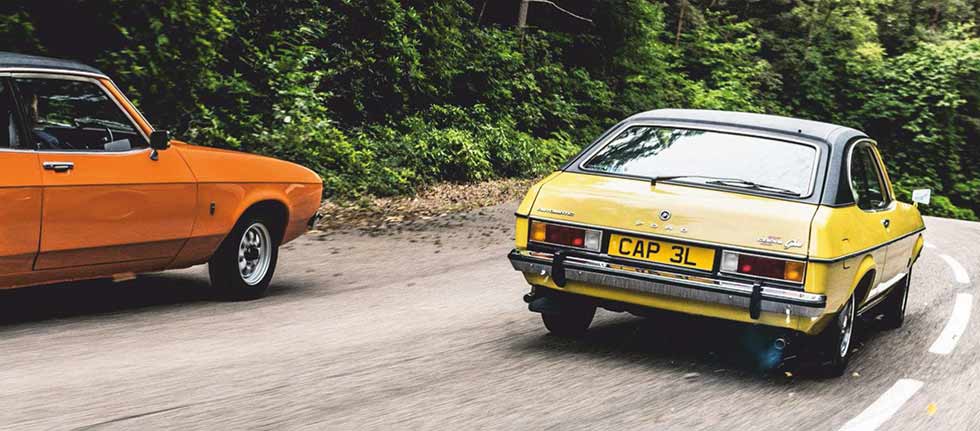
Mechanically it’s the same deal, but here with the automatic gearbox and extra heft of the MkII having a considerable effect on the car’s 0-60mph time. Ford’s own lightweight C3 unit replaced the earlier Borg-Warner Type 35 auto ’box and acquits itself well – shifts are perceptibly smooth, and it adds another layer of lazily swift progress to that 3.0-litre lump. Indeed this has always been owner Mike Foreman’s go-to car for European touring, so easy is it to pilot. The increased weight also makes itself known with a heavier tendency to roll through tight corners, but the payback of that softer suspension is its ability to mop up Britain’s blighted road imperfections with ease.
Inside, high-back front seats, thick-pile carpets and velvetesque Rialto fabric provide the cabin its Ghia touches, but my, did you pay for the overall package. It cost £549 more than the mechanically identical 3000GT – even more in this case, because with the auto box option ticked it rose yet further to £2,720. Despite still topping the UK sales charts, and the arrival of the special Midnight Black ‘S’ model, Ford’s year-on-year Capri sales continued on a downward journey. With the Ghia models already being built in Cologne, by 1976 Ford UK’s Halewood plant concluded its Capri rollout, with all production switching to Germany, as it concentrated instead on the Escort.
Come 1977 and a familiar friend returned to the beat – the X-Pack. Why not? While the MkI had basked in the afterglow of repeated European Touring Car Championship successes on the Continent, the MkII 3000GT had remained relevant by dominating its class in the British Touring Car Championship. With those visions of successful racers imprinted in the public consciousness – albeit not as hairy visually or mechanically as the RS2600 and RS3100 – it was time to unleash X, and with the new package you could go as mad as you wished.
Brake kits offered ventilated discs, suspension kits anti-dive technology and stiffer set-ups, body kits wild front spoilers, a rear spoiler and flared arches, wheels saw seven-inch-wide four-spoke RS alloys offered and mechanically it was possible to go for a triple carburettor engine conversion for 170bhp from the 3.0-litre V6. As a last hurrah for the MkII it was a wild time (and it wasn’t just confined to the Capri, with X-Packs pushed across the entire Ford model range), rallying legend Bjorn Waldegard giving an advertising clarion call to drive one last torrent of sales and see it off into the sunset of retirement.
Of course our standard example is the antithesis to all that glorious nonsense – sober-lined, smart-suited inside and with the throbbing familiarity of that old un-messed-around-with Essex friend under the bonnet. It remains a pertinent reminder of the decade, and the top end of the MkIIs.
Owning a Capri MkII 3.0 Ghia
‘I owned 17 Capris in my heyday, but that’s been trimmed down to six – one MkI, two MkIIs and three MkIIIs,’ says Mike Foreman. ‘When I left school in the summer of 1977 all my mates bought MkIs – £500 would get you a decent car – but I saved three times that and bought a MkII Ghia. It was a labour of love, but I retain a soft spot for the model – it was my first taste of a Capri.
‘It’s far better to buy one that someone has put all the work and money into, unless of course you like doing it. I rebuilt a 2.8i some years ago, but it’s a costly thing to do. ‘This particular car hasn’t seen the light of day for five years, since the water pump went. I fitted it last night to get it here. Prior to that it has been abroad many times to German, Dutch and Belgian car shows. However, the onset of children – I have six, from three months to 27 years-old – has temporarily stopped that.’
‘Increased weight means a tendency to roll in corners, but softer suspension sees it mop up Britain’s road imperfections’
TECHNICAL DATA FILE SPECIFICATIONS 1974 Ford Capri MkII 3.0 Ghia
Engine 2994cc ohv V6, Weber 38DGAS carburetor
Max Power 138bhp @ 5100rpm
Max Torque 174lb ft @ 3000rpm
Transmission Three-speed auto, rear-wheel drive
Steering Rack and pinion
Suspension Front: MacPherson struts, coil springs, telescopic dampers, anti-roll bar. Rear: live axle, half-elliptic leaf springs, anti-roll bar, telescopic dampers
Brakes Discs front, drums rear, servo-assisted
Weight 1170kg (2580lb)
Performance 0-60mph: 9sec; Top speed: 122mph
Fuel consumption 23mpg
Cost new £2444
Classic Cars Price Guide £3000-£19,000

1983 Ford Capri MkIII 2.0S
By sticking to its tried-and-tested formula, and familiar mechanical and powerplant layout, Ford had kept the Capri essence intact. Certainly more so than in the United States where the third-generation Mustang had sufered the dual ignominies of a re-style that led to it resembling a Japanese econo-box, and multiple engine power downgrades that left it an emasculated shadow of the once glorious original. Of course we now know that Ford had other ideas on pulling the Capri plug, convinced that it could keep the model germane as it moved quickly towards the Eighties – and just as buyers thought it was on the way out, they pulled them back in. As per the bean counters’ usual deportment this restyle was to be completed with as little financial outlay as possible.
Unlike the MkII, in which every body panel had been different from its predecessor, there were few changes to the MkIII. In the best sleight of hand since Karmann’s top-and-tail transformation of Triumph’s TR5-into-TR6, the design engineers under the direction of Uwe Bahnsen managed to produce a car that looked like a fresh production model.
Sit Kris Saines’ Capri MkIII 2.0S next to our MkII and it takes a while before the panel similarities begin to make themselves clear. Lengthening the front edge of the bonnet and pushing it forward endow the MkIII with a brooding, furrowed brow, but it’s the four headlamps – something the designers had to fight hard for because of the increased cost – that change the game completely, defining the spirit of the hardest-charging Capris to date.
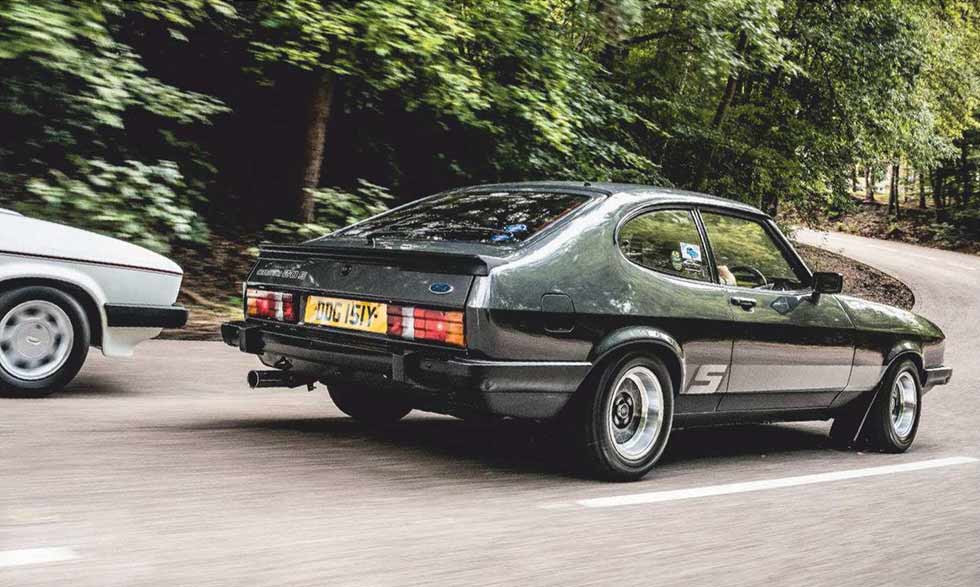
On the flanks the Strobe ‘S’ decal linking the new black wraparound bumpers shout speed, as do the integrated chin spoiler and rubber rear ducktail spoiler. Binning the chrome only enhanced the new look. The result is one mean-looking brute of a car. But the changes were more than a marketing man’s dream – along with the aeroffoil radiator grille and lower bonnet line they helped reduce the MkII’s almost criminal coefficient of drag from 0.428 to 0.374. And those front-end changes reduced the Capri’s notorious front-end lift by 18 per cent. That subtle rear spoiler reduced rear-end lift by a whopping 60 per cent.
Settle down into the 2.0S and it’s most definitely a Ford from the Eighties. That rubberised grey sports steering wheel and profusion of grey plastics would become the mainstay of Blue Oval interiors. The material on optional Recaro seats – a must-have on any sporting Ford of the era – matches the strobe effect on the exterior, and the driver’s seat hugs your lumbar area with the fearsome grip of an east-end gangster’s handshake.
And that’s a good thing, because this is the best-balanced and most composed Capri to date. All but the most basic Capri MkIIIs had gas-filled dampers as standard, and to those the S added stiffer springs and thicker anti-roll bars. As a result, this Capri S feels taut and sharp through long sweepers; if matters tighten on a B-road the lighter Pinto four-cylinder unit sees the steering load up predictably. There’s also a welcome liveliness and neutrality about it, but of course you can still break the tail away on demand with a bootfful of throttle.
Without big brother 3.0-litre S’s extra engine weight there’s less nasal waywardness, even if low-speed manoeuvres remain demanding. The lip-side is acceleration that’s brisk rather than brutal in nature – it’s a question of priorities. What’s it to be, a choice between poise and grunt? Of course in the minds of many a Capri isn’t a Capri without a V6. But that ignores the fact that for many years the 1.6-litre Pinto-powered models remained the best-sellers. In fact, even the 1.3-litre sold in the high single-figure thousands during the Seventies.
There’s no doubt that even today the mean MkIII obliterates the memory of the stultifying MkII. The time for Terry McCann’s amateur boxer in Minder was over, because The Professionals were in town. That TV programme is synonymous with Bodie’s 3.0-litre S – there’s enough pace here to have you imagining having a quick shave with your Remington before jumping in and wheelspinning away in hunt of the bad guys. And once they had been disposed of, some birds.
Owning a Capri MkIII 2.0S
Administrator Kris Saines’ uses his MkIII 2.0S as his daily driver. ‘I paid just under £3k nine years ago. I was looking for a nice usable classic in the classifieds and this one just popped out at me. I’d had Fiestas before so it had to be Ford, but even back then Anglias and Escorts were too much money.
‘It was in decent condition, having been dry-stored for ten years before being reconditioned and driven a little bit. It had 86k on the clock but now has 140k, so it gets about. For me classics are to be driven and this one certainly is.
‘It’s had a full body restoration with the underside Waxoyled and is all fairly standard – exhaust, air filter, wheels and suspension apart. I do some maintenance myself and budget around £2k per year to run it. The thing I love is that it keeps up with modern traffic and for its age isn’t bad on fuel, returning around 25mpg. ‘
TECHNICAL DATA FILE SPECIFICATIONS 1983 Ford Capri MkIII 2.0S
Engine 1993cc ohv 4-cyl,Weber 32DGAV twin-choke carburettor
Max Power 98bhp @ 5200rpm
Max Torque 112lb ft @ 3500rpm
Transmission Five-speed manual, rear-wheel drive
Steering Rack and pinion
Suspension Front: MacPherson struts, coil springs, telescopic dampers, anti-roll bar. Rear: live axle, half-elliptic leaf springs, anti-roll bar, telescopic dampers
Brakes Discs front, drums rear, servo-assisted
Weight 1103kg (2432lb)
Performance 0-60mph: 10.8sec
Top speed: 111mph
Fuel Consumption 23mpg
Cost new £3664
Classic Cars Price Guide £1250-£9250
‘The seat hugs you with the grip of an east-end gangster’s handshake’

1987 Ford Capri MkIII 2.8i
The MkIII offered buyers the greatest number of special editions so far – GT4, Cameo, Tempo, Calypso, Cabaret and Laser to name a few. Always trim and dress-up changes only, they were an attempt to burnish sales and fend of competitors like Opel’s Manta B, which had finally got into its stride.
With sales having dropped from 85,420 in 1979 to 41,755 the following year, once again it appeared that the only way was down. We’d been along this road before though, so write Ford of at your peril. Cue the setting up of the Special Vehicle Engineering department and its development of The Ford Capri MkIII 2.8 Injection to take the fight back to its competitors and give the Capri one final ling.
Led by Rod Mansield, once of the famed Advanced Vehicle Operation (AVO) department, it took on the task of developing the revitalised Capri. Of course, in the best possible Ford style, this meant having a good old fumble through the company’s parts bin. The venerable Essex V6 was canned, with the fuel-injected Cologne V6 from the Granada coming in – necessitating a different front cross member and gearbox bellhousing.
In 2792cc form it was a more powerful version of the one already being used in German-market cars, so SVE knew it’d it. To this, it added a large bore twin exhaust system and an oil/water heat exchanger.
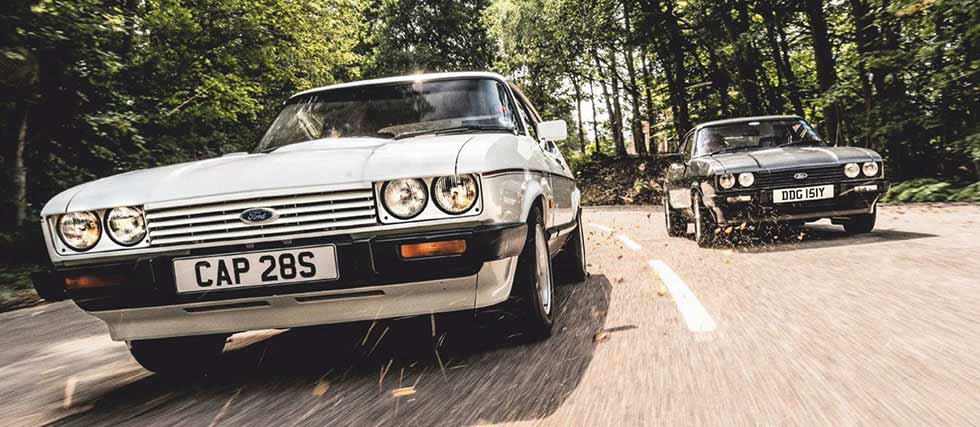
Peak torque was down from 174lb ft to 162lb ft, but with 160bhp at 5700rpm this was by far the most powerful Capri (X-Packs aside) to date. Initially it came in manual four-speed form, until the Sierra XR4i’s five-speed box became standard. But it was on the handling that most work was done, SVE lowering the ride height by 0.8in, fitting firmer springs, single leaf at the rear, and anti-roll bars, and Bilstein gas-filled struts and rear dampers to consign the memory of mid-corner wallow to the preceding two decades.
At launch in 1981 it cost £7995, some £661 more than the final 3.0-litre Ghia. The price proved not to be a barrier and the positive reception was instantaneous. In his test of the 2.8i for the October 1981 issue of Classic Cars, editor Roger Bell said, ‘It’s a car for serious drivers, well sorted by people who are serious drivers.’ It was also £1500 cheaper than the Alfa GTV6 it went up against. If the 2.8i looks less threatening than its fellow MkIII, put that down to the colour scheme and more restrained decals. The fuel-injected V6 fires up in a less bellicose manner than its Essex ancestor, and that feeling continues throughout the driving experience. While the 3.0S is all Oliver Reed, drunk and belligerently telling all and sundry to ‘bugger of’, the 2.8i is Gary Oldman, a smoother, and more reined hell-raiser for a new age.
The earlier car feels agricultural in power delivery and handling by comparison. While revving was anathema to the 3.0 unit, the injected 2.8 whistles happily through to 6100rpm – only unleashing a roar from its twin tailpipes at the upper end of its range. You lose some mid-range grunt, but soon adapt to using the shorter gear lever more often. Where the 3.0 Ghia grabs you by the scruff of the neck, it’s you doing so in the 2.8i because you drive it considerably harder on throttle and steering.
Stopping power is far superior thanks to ventilated front discs, but change down, feel the rear end squat and power into a corner and… it’s transformative, in Capri terms, anyway. Where previous big V6 models would have been on the very edge of ragged, this remains neutral and closer in feel to the 2.0S. And it’s able to devour them at far faster speeds with the benefit of a limited-slip differential on this later Special. You have to stop and remind yourself that underneath this car remains the same essential layout dating back to the late Sixties.
All this takes place in a cabin boasting leather and clothtrimmer Recaro seats that remains relatively reined even under the heaviest punishment; no wonder this last hurrah proved so popular with another 24,592 shifted until its final incarnation. Ford being Ford, it had to end with a special run-out model, the 280, available for £11,999 in Brooklands Green with 15-inch, sevenspoke alloys and full-leather interior in Raven Black.
Production ended in 1986, with the final stock actually sold in 1989, by which time 398,440 Halewood and 1,524,407 Cologne/ Saarlouis Capris had been produced. It had been quite a ride.
Owning a Ford Capri MkIII 2.8i
MkII 3.0 Ghia owner Mike Foreman also owns this immaculate 2.8i, ‘I wanted to buy this car in 1985 because it’s so original. It was for sale for £6000, but with my mortgage it wasn’t attainable. A friend bought it and I asked for first refusal if he ever sold it. He did sell it – only not to me. So I got friendly with the new owner and made the same request. A couple of years passed and he phoned me saying he wasn’t using it and wanted a track car. I paid £6000 for it 15 years ago. It came to me in the end.
‘The MkII remains my favourite, but if I were buying one for the first time I’d go for a MkIII because they are more widely available at an affordable price. You also get more bhp, a better suspension set-up and improved reliability from the injection system. They’re also a bit more luxurious inside. ‘Parts are fairly expensive for all models, so the best advice is to find an example where most of the work has already been done for you.’
TECHNICAL DATA FILE SPECIFICATIONS 1987 Ford Capri MkIII 2.8i
Engine 2792cc ohv V6, Bosch K-Jetronic fuel injection
Max Power 160bhp @ 5700rpm
Max Torque 162lb ft @ 4200rpm
Transmission Five-speed manual, rear-wheel drive, limited-slip differential
Steering Rack and pinion, power-assisted
Suspension Front: MacPherson struts, coil springs, telescopic dampers, anti-roll bar. Rear: live axle, semi-elliptic single-leaf springs, anti-roll bar, telescopic dampers
Brakes Discs front, drums rear, servo-assisted
Weight 1168kg
Performance 0-60mph: 8.2sec;
Top speed: 126mph Fuel
Consumption 22mpg
Cost new £7995
CC Price Guide £2.4k-£16k
‘It consigned the memory of mid-corner wallow to the preceding two decades’

Verdict The Big Test Ford Capri at 50
There’s no doubt that the Capri left an indelible mark on the psyche of numerous generations of Blue Oval fans both at home and abroad. Although there have been longer-lived production designs, if we put it in musical terms then the car’s impressive longevity becomes clear.
Released when the The Beatles were in their heyday, the Capri saw of the Fab Four, the onset, body and decline of disco, then witnessed the rise of glam rock, the punk movement and new romanticism. In fact, when Ford sold the last one, pop music was in the ascendency and boy bands were in full low.
Buy any of these Capris and while you essentially get the same package, you buy into its respective decade too. Ford knew what its public wanted and provided it by the shovel load. The outlier of course is the 2.8i, which had a reining effect on high-speed performance and gave the run-out model a triumphant final hurrah worthy of its illustrious predecessors.
If we remove the key affordability factor then the early cars should be discounted – more expensive to buy, and to restore. But then there’s their looks… so delicate and of the time – decisions, decisions.
For a bang-for-buck Capri then there’s no doubt it should be the MkII, but not many good ones survive, and should you pass an earlier or later relative on the road you’d perhaps be a tad jealous of their lines. Cherry-picking the best features of each iteration would be fun. Personally, I’d have the subtle lines of the 2000GT XL, the quad headlights of the 3000GXL, the rarity of the 1.3L, the aural brutality of the 3.0 Ghia, the interior of the 2.0S and the performance of the 2.8 Injection Special – there, easy. To quote contemporary modern American songstress Taylor Swift, ‘Oooh, look what you made me do. Look what you made me do.’
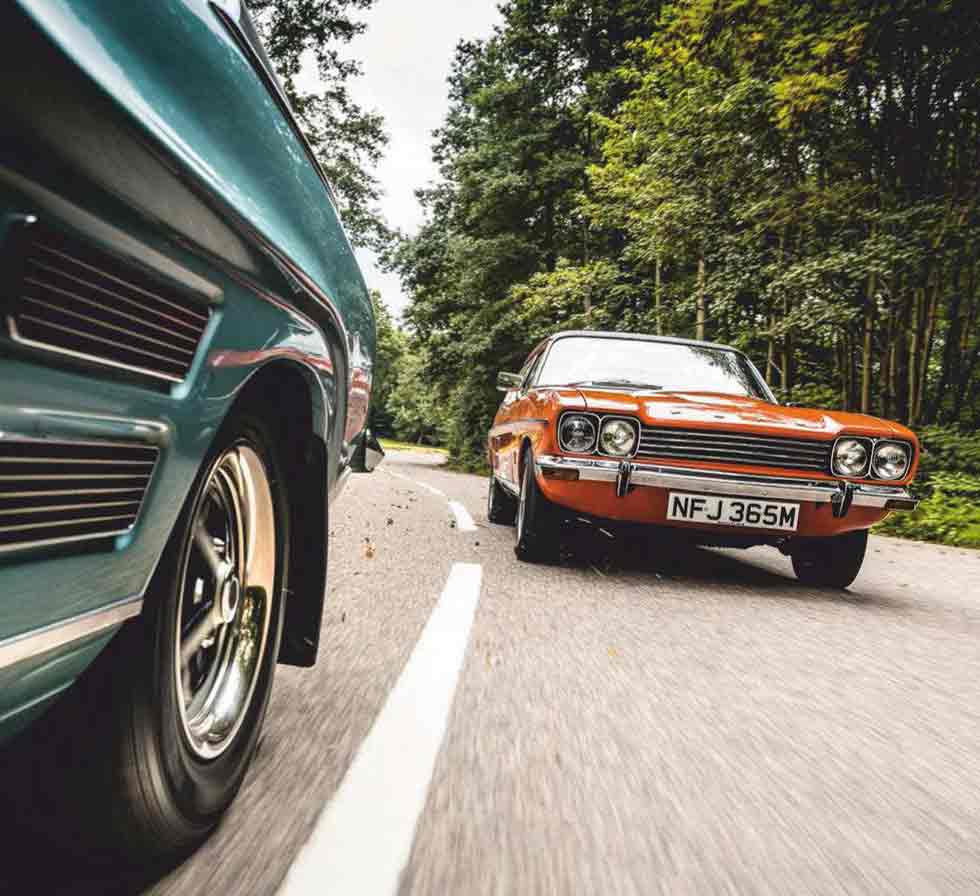
It’s true, just like the Mustang in the US, the Capri set the blueprint for every future visit to a car showroom, generation after generation speccing, tweaking and stretching just that little bit further for the next trim level. So given that my ideal chimera Capri isn’t available, which is going to be? It’d have to be the 3000GXL – V6 power, formidably cool looks and a thumping drive.
Don’t agree? Well, just as Ford intended, the choice is yours and there’s lots of it.
Thanks to Surrey Capri Club (surreycapriclub.co.uk), Ford Capri MkI Owners Club (caprimkIownersclub.com), Capri II Register (capri2register.co.uk), Tickover (tickover.co.uk), Capri Club International (capriclub.co.uk), Coleford Classics (01373 813317) Brooklands will be hosting the Capri 50th Anniversary Day on September 8, 2019. email [email protected] for details.
In musical terms the Capri’s longevity is clear – it was born to the Beatles and saw in the New Kids on the Block’
The special ones
Capri RS2600
The original homologation special; 3532 built. German-built, LHD-only and powered by a 150bhp, 2637cc long-stroke version of the Cologne V6 with Kugelischer fuel injection.
Tickford Capri
Base 2.8i re-engineered to produce the ultimate Capri. Expensive and no two the same – 205bhp turbo V6, leather and Wilton carpet interior, disc brakes all round, and wild styling.
Perana
MkI 3000 with a 5.0-litre small-block V8 squeezed under the bonnet by South-African tuner Basil Green. Modified suspension and a Falcon rear axle helped tame its 285bhp.
Zakspeed Turbo
Turbo special for Germany was LHD only; 200 made. Zakspeed added a Garrett turbocharger to the 2792cc V6 for 188bhp, plus GRP wheelarch extensions and big spoilers.
X-Pack
Series X kits for MkII and MkIII targeted performance, handling, roadholding and appearance. Ford advertised ‘as much or as little as you like’ could be done.
Capri RS3100
Last-gasp UK-built, RHD-only MkI homologation model; 3.1-litre carb-fed Essex V6 had 148bhp but more torque than RS2600. Spoilers front and rear reduced lift. Only 248 made.
How to bag a Capri with confidence
Says Angus Tick of Dartford-based model specialist Tickover, ‘You’ll never struggle to maintain a Capri mechanically; it’s just the rust that gets them, so try and find one that is as solid as possible.
‘Floorpans are similar across all generations, but it’s very difficult to get body panels for the MkI. Later cars had better underseal although it was still a bit feeble, and sunroofs have drainage tubes that run into the sills of the car – if it rains they ill up with water. All examples aren’t very watertight, so check front footwells and the sills where they meet the floorpan, the rear spring mounts and more.’
Mechanical parts were shared with contemporary Fords including Cortinas and Sierras so are easy to get hold of, and more difficult-to-source items like older 3.0-litre gearbox bearings can be had. ‘There’s always new-old stock on eBay, so you can still get them’.
‘On the engine, gearbox and differential, check for any untoward noises. The 2.8-injection models are particularly prone to overheating so look for brown water staining in the engine bay, and make sure you get it fully up to temperature on a test drive.’
Essex, Cologne and Kent engines are strong, as are gearboxes and replacement parts are readily available from specialists. Parts for Pinto engines are scarcer – so breakersyard Sierras might be your only option.
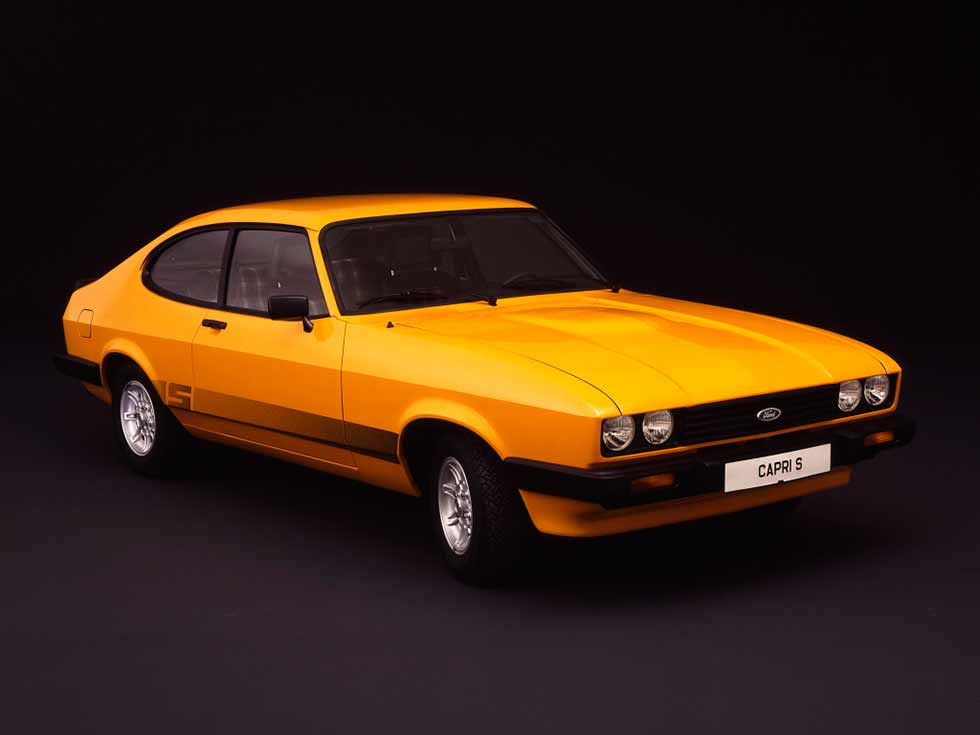
Tickover says that while value is condition dependent for all models, the 3.0-litre cars particularly sought after. ‘My pick would have to be a 3.0-litre MkIII without a doubt – it’s such a great engine.’
‘I raced one’
Jochen Mass He took the 1972 ETCC title at the wheel of an RS2600. So just how good were the racing variants? Photos LAT Photographic Motorsport Images & Sutton Motorsport Images.
The public always backed the underdog, be it a Capri or BMW’
The first time I drove the RS2600 was in the 1970 European Hill Climb Championship,’ recalls Jochen Mass. ‘It was half ready really, not entirely developed, but I liked it a lot and absolutely thought it could be successful. That was the start of the thrilling competition between the Schnitzer BMWs and the Capris. They were a bit stronger at the time and Ernst Furtmayr beat me on a regular basis. I was very close, but not quite there.’
By 1971 the early 230bhp Weslake-developed V6 engines had been tweaked to reliably deliver 260bhp, and coupled with an improved chassis and aerodynamics package. ‘That year I won the German Championship hands down, winning every race. The strong points of the car were the handling, which was very good. The steering was a bit heavy, but it was very neutral through corners. The early cars were not that powerful, but it quickly became a lot better.’
In that same year Dieter Glemser won the European Touring Car Championship title in an RS2600, and in 1972 – despite Jochen Neerpasch and Martin Braungart’s defection to arch-rival BMW – it was Mass who took the title, winning five times. ‘Needless to say it was down to my superior driving! Although technically the car was absolutely on the spot.’
By now the two teams were involved in an epic racing ding-dong. ‘We were really dominating BMW, and they didn’t like that. That’s when they came with the wing. Obviously we had restricted aerodynamics with just a little ducktail, and then they began to dominate us. I have a nice memory of the leading the first lap of a race that season with no aerodynamics and with the public it was always the underdog, be it Capri or BMW, that it supported. People really liked the Ford Cologne cars because they knew where they came from. Was it frustrating? What’s frustrating when you’re young and racing – no big deal.’
It wasn’t until mid-season in 1973 that the new BMW aero package arrived but its effect was instant, worth some 15 seconds per lap at the Nürburgring and over 8 seconds per lap at Spa. The Capris struggled to maintain their competitiveness and Toine Heizemanns surged to the ETCC title in his BMW 3.0 CSL E9.
After a bit of a delay the Capri did finally receive its aerodynamic package, alongside a new Cosworth-developed V6 engine in the new RS3100. ‘There were openings on the front spoiler that could be adjusted so we could increase or decrease the downforce, although I’m not sure how effective it was. The engine was better though, lighter and now up to 450bhp.’ The RS3100 was a success, notching up eight wins over the next two seasons, but by then BMW had pulled the plug on its works racers. ‘Despite BMW’s absence, the RS3100 was less dominant than the RS2600 for the simple reason that the others had caught up. They were great iconic cars of the day and an absolute match for the BMWs. My only regret is that we don’t have saloon cars like that today.’
